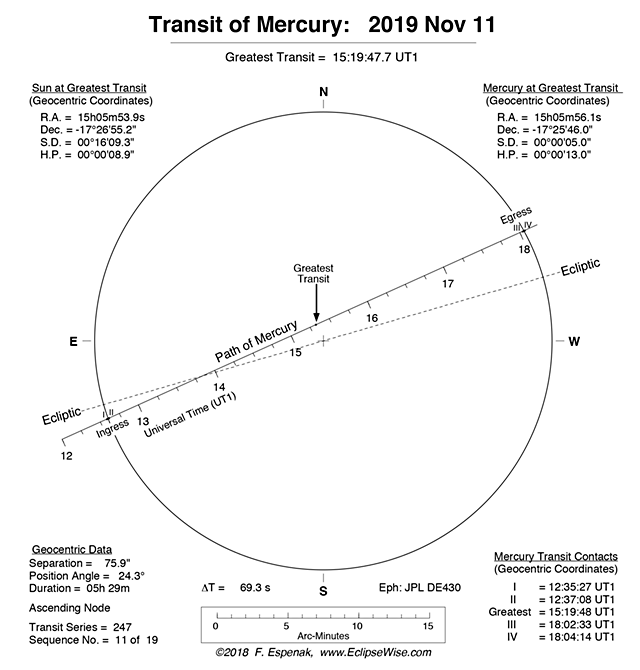THE USM SOUTHWORTH PLANETARIUM
207-780-4249 www.usm.maine.edu/planet
70 Falmouth Street Portland, Maine 04103
43.6667° N 70.2667° W
Altitude: 10 feet below sea level
Altitude: 10 feet below sea level
Founded January 1970
Julian date: 2458646.5
"I have not failed. I've just found 10,000 ways that won't work."
-Thomas Edison
THE DAILY ASTRONOMER
Wednesday, June 12, 2019
Explaining a Transit Series
152!
152!
That is the number of days currently separating today and November 11, 2019, the date of the next Transit of Mercury. Provided the skies are clear, we here in the eastern US will be able to watch the entire event. Conveniently, the transit begins in the early morning and ends in the early afternoon. We're truly hoping for clement weather as we eastern US observers won't see another Mercurian transit until May 7, 2049. For this reason, we will periodically revisit this event over the next five months. In so doing, we hope to be able to explain the many facets involved in such a rare celestial event.


Referring to the graphic above, look at the information listed in the lower left hand corner: Transit Series = 247 Sequence No = 11 of 19
What precisely does that information tell us and why is it helpful to us when attempting to predict other transits?
A transit of Mercury series refers to a sequence of transits, each of which is separated by almost exactly 46 years. After this period of time, a transit will recur with nearly the same type of path around the same time of year. This repetition occurs because 46 revolutions of Earth is approximately equal to 191 revolutions of Mercury. So, after 46 years, Earth and Mercury will almost occupy the same positions relative to each other.
The November 11, 2019 Transit will be the 11th transit within the Transit Series 247*
If we look at the dates of the previous transits within the series, we can see how successive dates are quite close, but deviate after a few iterations:
[10] November 10, 1973
[Historical note: NASA launched Skylab 4 less than a week later]
[Historical note: NASA launched Skylab 4 less than a week later]
[9] November 10, 1927
[Historical note: Leon Trotsky was expelled from the Soviet Communist Party two days later.]
[8] November 6 - 7, 1881
[Historical note: the gunfight in the O.K. Corral in Tombstone, AZ happened about two weeks earlier.]
[7] November 7, 1835
[Historical note: Halley's Comet reached perihelion (closest distance to the Sun) about nine days later.]
[6] November 5, 1789
[Historical note: About two weeks later, the State of New Jersey became the first state to ratify the Bill of Rights]
[5] November 5, 1743
[Historical note: French astronomer Joseph-Nicolas Delisle organized worldwide coordinated observations of this Mercurian transit in an effort to determine the solar parallax.]
[4] November 3, 1697
[Historical note: St. Paul's Cathedral in London opened a month later.]
[3] November 3 - 4, 1651
[Historical note: the second transit of Mercury to have been observed. Jeremy Shakerly observed the transit from the Indian city of Surat. Note on this note: Pierre Gassendi observed the 1631 transit of Mercury.]
[2] November 1, 1605
[Historical note: Guy Fawkes' "Gunpowder Plot" to blow up the English Houses of Parliament was foiled four days later.]
[1] November 1, 1559
[Historical note: Elizabeth I was crowned earlier that year.]
Based on this information, can you predict when the following two transits in this series will occur?
November 11, 2065
November 13, 2111
The final transit in the 247 series will occur on November 20, 2387.
As each transit in a given series occurs, the transit path is slightly displaced from the other path. The very first transit of a series will happen along either the upper or lower limb, depending on the node around which the transit occurs.** The 247 Transit Series, as we can see on the graphic, occurs at the ascending node. Therefore, the first transit in Series 247 (in 1559) brought Mercury along the Sun's lower limb. As this transit is nearly at the midpoint (11 out of 19), the transit path is almost central. During the final 247 Transit (in 2387), Mercury will just skim the Sun's upper limb. Forty six years later (2433), Mercury will be too far from the node around November 20th for a transit to occur. The transit series will have ended.
Transit series, like Saros series for eclipses, provide a handy way for us to predict when future celestial events will occur. They are also a very disquieting reminder of our mortality, as we can speak with conviction about events scheduled to transpire centuries in the future.
*Yes, perhaps you are find this number a bit puzzling. The transit on November 7, 1631 was the first transit of Mercury to have been observed. Transit series are listed in a 100,000 year canon of Mercurian transits. They are numbered according to when they reach their midpoint.
**Just a note about "nodes." When a planet crosses the "ascending node," it is moving north of Earth's orbital plane. When a planet crosses the "descending node," it is moving south of Earth's orbital plane.